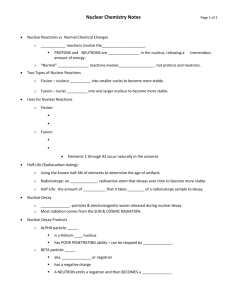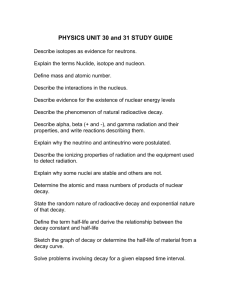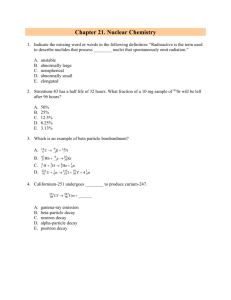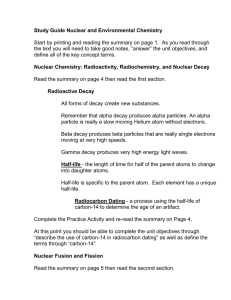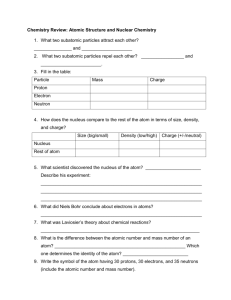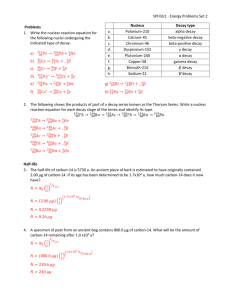Atomic Physics Problems Set
advertisement
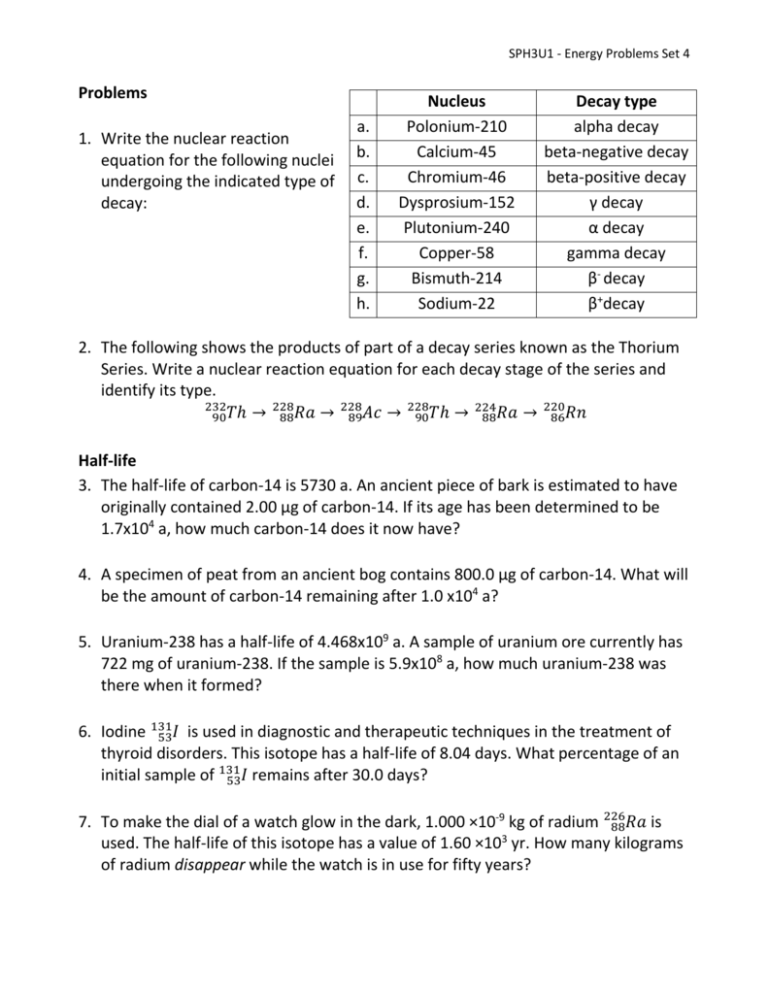
SPH3U1 - Energy Problems Set 4 Problems 1. Write the nuclear reaction equation for the following nuclei undergoing the indicated type of decay: a. b. c. d. e. f. g. h. Nucleus Polonium-210 Calcium-45 Chromium-46 Dysprosium-152 Plutonium-240 Copper-58 Bismuth-214 Sodium-22 Decay type alpha decay beta-negative decay beta-positive decay γ decay α decay gamma decay β- decay β+decay 2. The following shows the products of part of a decay series known as the Thorium Series. Write a nuclear reaction equation for each decay stage of the series and identify its type. 232 228 228 228 220 224 90𝑇ℎ → 88𝑅𝑎 → 89𝐴𝑐 → 90𝑇ℎ → 88𝑅𝑎 → 86𝑅𝑛 Half-life 3. The half-life of carbon-14 is 5730 a. An ancient piece of bark is estimated to have originally contained 2.00 µg of carbon-14. If its age has been determined to be 1.7x104 a, how much carbon-14 does it now have? 4. A specimen of peat from an ancient bog contains 800.0 µg of carbon-14. What will be the amount of carbon-14 remaining after 1.0 x104 a? 5. Uranium-238 has a half-life of 4.468x109 a. A sample of uranium ore currently has 722 mg of uranium-238. If the sample is 5.9x108 a, how much uranium-238 was there when it formed? 6. Iodine 131 53𝐼 is used in diagnostic and therapeutic techniques in the treatment of thyroid disorders. This isotope has a half-life of 8.04 days. What percentage of an initial sample of 131 53𝐼 remains after 30.0 days? 7. To make the dial of a watch glow in the dark, 1.000 ×10-9 kg of radium 226 88𝑅𝑎 is 3 used. The half-life of this isotope has a value of 1.60 ×10 yr. How many kilograms of radium disappear while the watch is in use for fifty years? SPH3U1 - Energy Problems Set 8. The shroud of Turin is a religious artefact known since the Middle Ages. In 1988 its age was measured using the radiocarbon dating technique, which revealed that the shroud could not have been made before 1200 AD. Of the 146𝐶 nuclei that were present in the living matter from which the shroud was made, what percentage remained in 1988? Nuclear Fission 9. During a nuclear reaction, an unknown particle is absorbed by a copper 63 29𝐶𝑢 62 nucleus, and the reaction products are 29𝐶𝑢, a neutron, and a proton. Determine the unknown particle and the nucleus temporarily formed when the copper 63 29𝐶𝑢 nucleus absorbs the unknown particle. 10. A neutron causes 232 90𝑇ℎ to fission according to the reaction 232 1 𝐴 90𝑇ℎ + 0𝑛 → 𝑍𝑋 + 𝛾 a. Identify the unknown nucleus , giving its atomic mass number A, its atomic number Z, and the symbol X for the element. b. Nucleus X then undergoes β- decay, and its daughter does too. Identify the final nucleus, giving its atomic mass number, atomic number, and name. 11.A small sample of coal, when completely converted to energy, releases 4.5 × 1014 J of energy. Determine the original mass of coal, assuming the final mass is zero. 12.Calculate the mass defect, in kilograms, and the energy released, in joules, of the following nuclear reaction: 140 235 93 1 1 92𝑈 + 0𝑛 → 55𝐶𝑠 + 37𝑅𝑏 + 3 0𝑛 235 92𝑈 = 235.044 𝑢, 1 0𝑛 = 1.009 𝑢, 140 55𝐶𝑠 = 139.909 𝑢, 93 37𝑅𝑏 = 92.922 𝑢 13.How much energy, in MeV, is released by the following fission reaction? 235 92𝑈 235 92𝑈 = 235.044 𝑢, 1 0𝑛 + 10𝑛 → = 1.009 𝑢, 94 38𝑆𝑟 1 + 140 54𝑋𝑒 + 2 0𝑛 96 38𝑆𝑟 = 93.915 𝑢, 140 54𝑋𝑒 = 139.922 𝑢 SPH3U1 - Energy Problems Set 2 14.The energy released during each 235 92𝑈 fission is 2.0 × 10 MeV. How many kilograms of coal must be burned to produce the same energy as 1.0 kg of 235 92𝑈 if 7 3.0 × 10 J of energy is released when 1.0 kg of coal is burned? (n.b. 2.6 x1024 U nuclei are found in a 1 kg sample of uranium) Nuclear Fusion 15.One reaction to produce carbon in stars is as follows: 4 2𝐻𝑒 + 42𝐻𝑒 + 42𝐻𝑒 → 12 6𝐶 Calculate the mass defect, in atomic mass units, and energy released, in 12 electronvolts, of this reaction. ( 42𝐻𝑒 m=4.002603 u, 6𝐶 m = 12.00000 u) 16.Consider the induced nuclear reaction 21𝐻 + 147𝑁 → 126𝐶 + 42𝐻𝑒 . The atomic masses are 21𝐻 (2.014 102 u), 147𝑁 (14.003 074 u), 126𝐶 (12.000 000 u), and 42𝐻𝑒 (4.002 603 u). Determine the energy released, in joules, when the 126𝐶 and 42𝐻𝑒 nuclei are formed in this way. 17.Two deuterium atoms ( 21𝐻= 2.014102 u) react to produce tritium ( 31𝐻= 3.016050 u) and hydrogen ( 11𝐻= 1.007825 u) according to the reaction: 2 1𝐻 + 21𝐻 → 31𝐻 + 11𝐻 What is the energy released by this deuterium-deuterium reaction? 18.One proposed fusion reaction combines lithium 63𝐿𝑖 (6.015 u) with deuterium 21𝐻 (2.014 u) to give helium 42𝐻𝑒 (4.003 u): 2 1𝐻 + 63𝐿𝑖 → 2 42𝐻𝑒 a) How many of the above reactions would need to occur to supply the energy needs of one household for a year (estimated to be 3.8 × 1010 J)? b) How many grams of lithium would be needed if there are 8.673x1025 Li nuclei in 1 kg of a lithium sample? SPH3U1 - Energy Problems Set 19.The following shows the carbon-nitrogen-oxygen (CNO) cycle that occurs inside stars. Write a nuclear reaction equation for each stage in the cycle and identify its type. 13 13 15 15 12 14 12 4 6𝐶 → 7𝑁 → 6𝐶 → 7𝑁 → 8𝑂 → 7𝑁 → 6𝐶 + 2𝐻𝑒 Conceptual Questions 1. To which of the following objects, each about 1000 yr old, can the radiocarbon dating technique not be applied: a wooden box, a gold statue, and some plant seeds? Explain. 2. Some preserved seed were found and their age, through the technique of carbon dating, was determined to be 5000 years old. However, new evidence suggests that the amount of carbon in the air at that time is higher than previously thought. Are the seeds older or younger than 5000 years? Explain. 3. Compare and contrast nuclear fission and fusion. How are they alike? How are they different? 4. Why are neutrons such good projectiles for producing nuclear reactions? 5. Explain why nuclear fusion is much more difficult to obtain than nuclear fission 6. Why is nuclear fusion more desirable than nuclear fission for power generation? Explain. 7. The energy from nuclear fission appears in the form of thermal energy – but the thermal energy of what? Explain. SPH3U1 - Energy Problems Set ANSWERS 3. 0.26 µg 4. 240 µg 5. 790 mg 6. 7.53 % 7. 2.14 x10-11 kg 8. 91 % 9. p+, 64 30𝑍𝑛 233 10. a) 90𝑇ℎ b) 233 92𝑈 11. 5.0 g 12. 3.237 x10-28 kg, 2.91x10-11 J 13. 184 MeV 14. 2.8 x106 kg 15. 7.8 x10-3 u, 7.3 x106 eV 16. 2.2 x10-12 J 17. 4.0 MeV, 6.4 x10-13 J 18. a) 1.1 x1022 reactions b) 0.13 g
